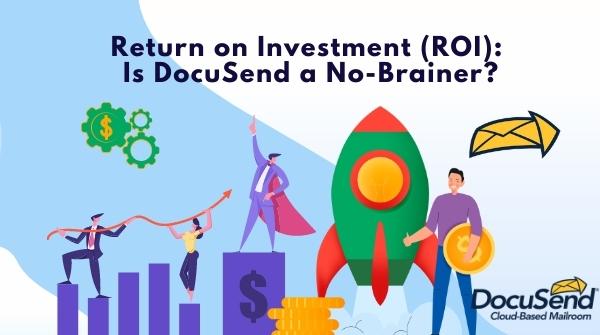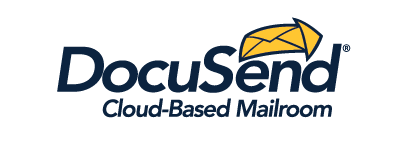Return on Investment (ROI): Is DocuSend a No-Brainer?
Authored by: Jim Stewart, Founder DocuSend, powered by MTI.
Small business owners recognize that a relationship with the right third party can provide a distinct advantage over their competitors. But the risk involved in procuring new software, equipment, suppliers, or service contracts can be considerable when you are operating on a tight fiscal budget. If you don’t make the right choices, you may have to start all over. And if you consider your time running an SMB to be at a premium, that’s a big loss.
“Time is money” is a long-established axiom, and it’s never been truer than for small businesses, whose owners simply can’t afford to waste a moment. That’s why many SMB owners and operators calculate an ROI when the allocation for a project is considerable. It quantifies the project’s value and helps eliminate the uncertainties of its worth to the business. Here is an example of how an ROI calculation looks in its simplest form:
| Sample ROI Chart | Cost | Savings | ROI |
|---|---|---|---|
| Year 1 | $25,000 | $4,765 | ($20,235) |
| Year 2 | 0 | $5,475 | ($14,760) |
| Year 3 | 0 | $6,965 | ($7,795) |
| Year 4 | 0 | $7,865 | $70* |
| Year 5 | 0 | $8,525 | $8,595 |
| Year 6 | 0 | $9,745 | $18,340 |
* Break-even in Year 4: ROI as a simple indicator of the true value of a project.
So, let's unpack this a little more.
If time is money, and ROI proposals like this eat up valuable resources to research, prepare, and implement, you have to ask yourself: Are there any technologies out there that are so advanced and simple to use that you don’t need to go through the ROI process at all? I mean, think of it: Could there be a system that you can try just once and know immediately whether it will save your business time, money, and resources?
In other words, are there any “no-brainers” out there?
There is one available right now!

It’s an invoice technology so advanced that you don’t need to conduct an ROI calc to see if it has value for your business. DocuSend users average a 50% savings over printing and mailing invoices internally.
Here’s an example of what happens in a small business that currently spends $25,000 per year on invoice print-to-mail distribution when they switch to using the DocuSend cloud-based mailroom:
| DocuSend ROI Chart | Cost | Savings | ROI |
|---|---|---|---|
| Year 1 | ** | $12,500 | $12,500 |
| Year 2 | 0 | $12,500 | $25,000 |
| Year 3 | 0 | $12,500 | $37,500 |
| Year 4 | 0 | $12,500 | $50,000 |
| Year 5 | 0 | $12,500 | $62,500 |
| Year 6 | 0 | $12,500 | $75,000 |
** Cost= Three minutes to upload file
A Miniscule Investment
DocuSend includes all materials, postage, and mailing services, and it only takes a few minutes to upload a file. The ** in the table is your total cost investment: a few minutes to upload. Too miniscule to measure in dollars and cents! It doesn’t matter how many documents your company mails, because the return will run parallel with your volume.
To clarify, the internal cost for an SMB to mail a one-page invoice averages about $1.88 per envelope mailed. That includes forms, materials, printing, folding, stuffing, applying postage, and labor. DocuSend’s cost is $1.28 per envelope mailed. So, your annual savings is $1.28 x your annual volume.
Can’t get any simpler than that, right? It should be as easy a decision as opting to use a payroll service to distribute your employees’ wages.
Sure, as easy as falling off a log. So why isn’t everybody doing it?
The Emotional Connection
SMB owners occasionally tell me how much they love the simplicity and time savings DocuSend offers, but they still hire relatives (or some variation) to spend hours printing, stuffing, folding, and stamping hundreds of envelopes just to bill their customers. To paraphrase, I hear things like, “It’s a tradition, Jim, and my family would probably kill me if I replaced them with DocuSend!”
I don't know exactly how many SMBs are in similar situations, but I know it is not unique. It makes me think back to something that my amazing wife showed me years ago.
The Coffee Cup Connection

My better half likes to collect things, not the least of which are coffee cups. Sometimes she runs short on places to put them. She drinks coffee every day, whereas I only have an occasional cup on weekends. Her collection of mugs is stored in a cupboard above the stove. There must be at least fifty of them in there, and my attempts to open the cupboard door carefully enough to prevent an avalanche have not always been successful. Early one Saturday morning, I was quietly drinking a cup of coffee while congratulating myself on acquiring one of the mugs without setting off any landslides. She suddenly appeared out of nowhere and said with raised eyebrows, “James, what are you doing? That's my cup!”
Every cup she has crammed into that cupboard came from someone in her life that she loves. And every cup has a memory that means something to her. I think some of the would-be users of DocuSend feel the same way about certain people they hire to help them stuff envelopes.
But then I think: In this world of social media, how many more productive ways are there for full-time or part-time SMB employees to be occupied? Well, I believe there are plenty of them. In fact, I think stuffing envelopes is one of the worst ways they can fill up their day. As an SMB owner, it would be wonderful if you would consider inspiring other owners by sharing your ideas in the comments section below on how to best utilize your employees' time.
If you want to save the tedious hours it takes to do the menial task of printing, folding, and mailing invoices, statements, or any other important documents, make DocuSend your cloud-based mailroom. You can even sit back and enjoy a cup of coffee while we print and mail your documents for you.
Thanks to all the SMB owners and operators out there reading this. We’d love to know what you are saving by using DocuSend, or if you think the ROI example was helpful. Please share your ideas and innovations in the comments section.

